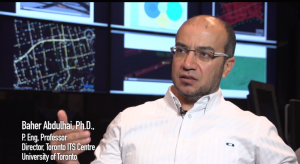We continually millions in research facilities to ensure that our staff, students and collaborators have the right equipment to meet research needs.
Below is just a sampling of our research labs and facilities.
Located within raw attic space of the historically designated 1904 Mining Building, the Goldcorp Mining Innovation Suite at the Lassonde Mining Building is designed and programmed to advance interdisciplinary collaboration between engineering education and industry. Organized to provide a separate entry and independent identity, the Centre provides a high performance studio environment which optimizes interior conditions for collaborative, group-based learning.
From the Architect of the Goldcorp Mining Innovation Suite
The ITS Centre and Testbed of the University of Toronto provides an instrumented, multi-jurisdictional, multi-agency transportation research and development environment linked to the traffic operations centres operated by the Ministry of Transportation of Ontario and the City of Toronto. Researchers and students at the centre focus of the development, testing, and evaluation of ITS technologies and applications. It is also a meeting ground for public, academic, and private practitioners and researchers to explore new approaches to transportation system operations and management.

Addressing transportation problems involves a complex interplay between technology, human perception, cognition and behaviour, and social, economic, and political systems. Therefore, transportation research is inherently multi- and interdisciplinary. At the University of Toronto, our definition of ITS is broad and inclusive. It involves applying information and communication technologies and other advanced methods and techniques, such as machine learning, to improve transportation system performance and the overall economic and social well-being.
The Structural Testing Facilities (STF) in the Department of Civil & Mineral Engineering is among the top few testing facilities in North America and has received numerous awards for the quality of research performed. The main laboratory facility spans the basements of the Sandford Fleming and the Galbraith building and includes numerous ancillary facilities such as a concrete mixing laboratory, machine shop, welding bay and woodworking area.
A unique Rock Fracture Dynamics Lab has been built with integrated geophysical monitoring, real time results visualization and numerical modeling capabilities. The main aim of this state of the art facility is to perform short and long term experimental rock deformation and geophysical imaging for the validation of coupled-process numerical modeling.
The main components and details are:
- A poly-axial servo-controlled rock deformation system
- Instrumentation for geophysical imaging
- A 256 processor super computer cluster for numerical modelling of the experiment
The facility is being used to perform innovative scientific research to address critical gaps in the science of rock fracture and enable new discoveries. Examples of the research areas include:
- Investigate how rock fractures are formed, coalesce and contribute to strength degradation, static fatigue, damage and permeability under complex mechanical, thermal and fluid regimes
- In a controlled environment, reproduce real Earth conditions at depths up to 4km
- Investigate how natural and induced fractures can be triggered and how this contributes to instability.
